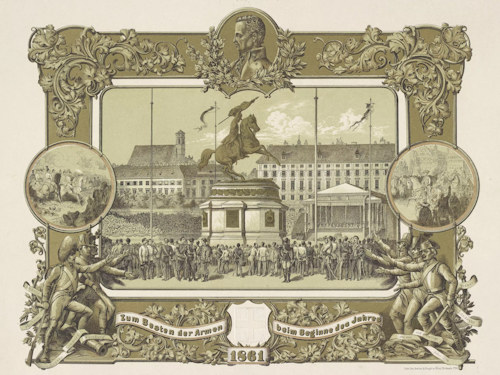
A huge equestrian statue dominates Heldenplatz square on one side of Vienna’s Hofburg palace complex. The monument honours the first man to hand Napoleon a significant military defeat: Archduke Karl.
- Bronze design by Anton Dominik Fernkorn
- Depicts the victorious Archduke during the Battle of Aspern-Essling in 1809
- Unveiled in 1860 in the presence of Emperor Franz Joseph
- Book a themed guided tour* of Vienna
- See also:
Karl 1 Napoleon 0

(A triumphal pose)
Austria and Vienna have a rich history of global import. But musical successes tend to outshine military ones. Understandable when Mozart and Beethoven lived here.
But the Habsburgs did become embroiled in numerous conflicts. As you might expect of any empire as locals started to wonder quite why they need pay allegiance to some monarch miles away in Vienna, and competitors cast a jealous eye on Austria’s natural resources and political influence.
Austrian military history is a mixed bag, but a few names stand out. One of the foremost being Archduke Karl (1771-1847), third son of Emperor Leopold II, brother of Emperor Franz II/I, and one-time resident in the Albertina.

(“The victor of Aspern; Archduke Karl and his generals” by Peter (Johann Peter) Krafft, 1867–1900, Wien Museum Inv.-Nr. 82301, reproduced with permission under the terms of the CC0 licence)
Karl (sometimes spelled Carl) had a long career in the imperial army but his name entered global military folklore on May 22nd, 1809, when he presided over what is widely considered to be the first military defeat of Napoleon in open battle.
Sadly for Karl and Austria, the Battle of Aspern (also known as Aspern-Essling) proved a minor blip on Napoleon’s CV.
Shortly after, in early July, the Frenchman defeated the Archduke at the Battle of Wagram. This marked the beginning of the end of hostilities. Just over three months later, the French and Austrians signed the Peace of Schönbrunn, though the terms favoured France enormously.
Still, nobody can take Aspern away from Archduke Karl, and Austria did not forget his achievement. Evidence of this comes in the form of the equestrian statue on Heldenplatz square at the very heart of Vienna.

(You can see the dome of the Naturhistorisches Museum in the distance)
The huge bronze work depicts Karl in an alleged scene from the battle. Emperor Franz Joseph himself commissioned the sculptor Anton Dominik Fernkorn (1813-1878) with the design.
Fernkorn also had a significant hand in the other equestrian monument on Heldenplatz, which honours Prince Eugene of Savoy.
The statue should have been unveiled in 1859 on the 50th anniversary of the famous battle. Unfortunately, military losses in Italy cast a shadow over proceedings, and the date moved to May 22nd, 1860.
The small reliefs at the top of the plinth list various prominent battles with Karl’s participation, beginning with Aldenhoven in 1793 (when the Archduke led a successful cavalry charge against the French) and ending with Znaim in 1809 (the final conflict between France and Austria in the war of the fifth coalition).

(Image from an 1861 New Year’s card showing the official unveiling of the monument on May 22nd, 1960; Hermann Engel (lithographer); Wien Museum Inv.-Nr. 9857/2; excerpt reproduced with permission under the terms of the CC0 licence)
You’ll find both Aspern and Wagram listed among those reliefs.
The three main inscriptions on the plinth itself read (my translations of the original German):
- To the heroic leader of the Austrian army
- To the tenacious fighter for Germany’s honour
- Emperor Franz Joseph I. to Archduke Carl of Austria, 1859
A fourth large relief features the coat of arms of the Archduke.
How to get to Archduke Karl
See the travel tips for Heldenplatz.
Address: Heldenplatz, 1010 Vienna